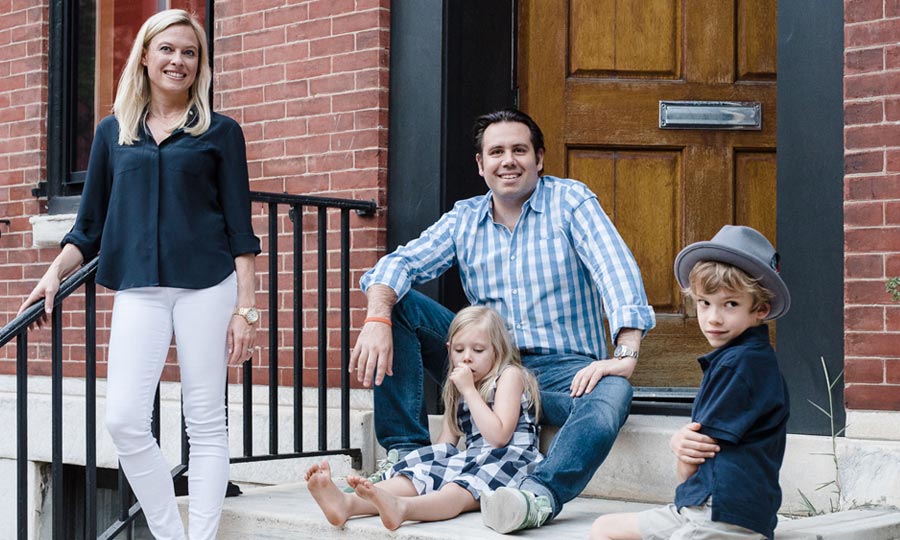How to Find the Best Philadelphia School for Your Child

Brooke and Chris DiMarco, of Rittenhouse, send Emilia, five, and Christian, seven, to Springside Chestnut Hill Academy. Photography by Christopher Leaman.
How to Find the Best Philadelphia Private School
Competitive, expensive … and yet a viable option for more city families than you might guess.
Q. What does it take to get into private school?
Truth is, Edward Snowden himself couldn’t wrench admission rates and application numbers from Philly’s league of private schools. Whether they’re citing “not wanting to create an undue frenzy” or “numbers that don’t actually reflect serious candidates,” the admissions directors at most local independent elementary schools give a range of reasons for their tight-lippedness. This much, however, is known: There are more applications than there are spots, and for the most part, the number of applications increases each year. This is especially true for private schools in Center City, in Northwest Philly and on the eastern Main Line.
That shouldn’t necessarily discourage you, though — the competition might not be as cutthroat as you think. “The best thing is to cast a wide net,” says Fairmount parent Jennifer Sokoloff, whose daughter — without any alumni connections or a last name that’s on a building — was accepted to all three city private schools she applied to. (She’s currently at Penn Charter.)
It goes without saying that schools will pay extra attention to alumni and siblings, and connections never hurt. (And if you have them, you should use them.) However, as Lois West, director of communications at the Philadelphia School, points out, “Philadelphia is a small place, and practically everyone applying knows someone. Maybe 20 years ago that was very helpful, but I would say not so much anymore.”
There are other reasons to believe it’s not all about whom you know and what you have. More than ever, diversity and “a good fit” are core values at these schools. (The latter is especially true for programs that are progressive or are based on Quaker principles.) Diversity doesn’t only come in the form of ethnicity and color — cultural, socioeconomic and geographic diversity all count.
What’s this all mean to you? If you’d like your child to go to private school, you should definitely apply — to a bunch of them.
One thing that’s critical to note: In most cases, your child’s best shot of getting into a private school is through the pre-K program. Yes, that might mean pulling Gemma from a preschool you love, and yes, it definitely means ponying up mega bucks for a year more than you planned. But except for individual students with major issues, the entire pre-K class moves up to kindergarten, which makes open spots there harder to come by. (Of course, schools vary. With approximately 40 spots, the Philadelphia School has one of the larger pre-K programs, while both Greene Street Friends and Friends Select have additional spots added to the kindergarten class. At Springside Chestnut Hill Academy, class size fluctuates depending on applicants.)
And if your kid didn’t get into his dream school at age five? Spots can open up mid-year as kids get older and family situations change, so you should stay in touch with the admissions office throughout the year.
While most schools are always happy to talk to interested parents, the process really begins the fall before your child’s class year. Children must be four when entering pre-K, so that means you’ll start going on open-house tours, putting through applications and booking play days and interviews the preceding fall. Clearly, a good Google spreadsheet is clutch.
Q. We can’t afford 12 full years of private school. Is it better to invest in an elite high-school education, or to have your kid learning Spanish at age seven?
If your objective is a fat welcome packet from the best possible university, private high school is probably a better strategic choice than private elementary school. The opportunities available to kids at top private schools can really make a college application sing: the international travel, the abundance of advanced coursework, the elite college-admissions help. (At Germantown Friends, for instance, each junior is paired with a faculty adviser to help hone college applications.)
And the smaller scale of many private schools helps out a lot with those testimonial letters. “It gives you more intimate relationships with teachers who write recommendations,” says Joan Koven, a Havertown consultant who guides families through the college application process. “The counselor load at a private school is much smaller.”
But if your focus isn’t so much an elite college as fostering a love of learning as early as possible, a private elementary school could be the right call. At the pre-K-through-8 Philadelphia School, for instance, many graduates enroll at public magnets like Central High and SLA.
And if you find that a public elementary school isn’t working for your kid, bail. Fast. “Developmentally, if you think your public school is terrible, get them out early. Because you don’t want your kid to fall behind,” says Jessica Kendorski, director of the school psychology program at the Philadelphia College of Osteopathic Medicine. “Catching up is difficult.”
4 Things to Know About Paying for Private School
Elementary school in a local private might range anywhere from $13,000 to $33,000 a year. But that doesn’t necessarily mean it’s out of reach.
Everyone should apply for financial aid. The amount of financial-aid money given out varies from school to school. At most schools, it’s need-based — but need, in this case, takes a lot of factors into account. It isn’t necessarily about how much income your family takes in. Rather, it’s about the family’s total financial picture. A parent who makes 500K a year but is, say, caring for a sick parent or paying for twins to go to Yale might be eligible for financial relief for elementary school. You’re also competing against the needs of the other applicants, not the public at large. So how much can you get? At Friends Select, some 35 percent of the students receive financial help, with the average grant around 15K; other schools may give a greater number of students less money. Many, like the Philadelphia School, try to make sure financial aid includes costs like after-school programs, so students can have a complete experience. And all try to make sure your aid is guaranteed from year to year.
Look beyond the schools. Children’s Scholarship Fund Philadelphia is one organization that offers income-based help for elementary-school-age students. There are also programs for merit-based grants. Some private schools will help navigate this process. Ask.
Don’t assume all private schools cost more than your car. It’s true that many area schools cost more than $20,000 a year. But some, like the Waldorf School and Greene Street Friends School (both in Germantown), are closer to $13,000 a year, and Greene Street guarantees that tuition will never go up by more than $100 per grade.
Call the grandparents. “Leave no stone unturned and no grandparent untapped,” advises Jane Berryman, a senior vice president at Ameriprise Financial Services. “It can come out of their lifetime giving allowance,” she says, “and it helps reduce their taxable estate. Just make sure the money is paid directly to the school, or it can be considered taxable income to the parents.”
Why I Chose … Private School
Joanne Jordan is mom to McLean, seven, and Patterson, three. They live in Center City, and McLean attends the Philadelphia School.
Sending McLean to private school — it’s not comfortable for me and my husband. It’s a financial strain. But we think education is the most important thing you can give to your kid. They might remember the trips and maybe getting that toy when they were nine, but a good education is more important to us than a trip to Mexico.
I had an Excel spreadsheet of when the submissions were due, who we were interviewing with, how much they charge annually. They’re all within a couple thousand dollars of each other, and they all go up incrementally. If you start in kindergarten, by eighth grade, you’re up there.
I want McLean to know that people come in all shapes and colors and sizes and creeds. Now, some people might scoff at that and say you have to live in a certain financial bracket [for private school], but the Philadelphia School has financial aid, and that does two things: It gives a child a chance to get a really great education, and it makes the student base more colorful, literally and figuratively.
TPS is a very special, different place. When we were deciding, I spoke to a lot of the eighth-graders at TPS, and it was like talking to a peer, not a kid. McLean is going into first grade now, and the way he speaks, the words he’s using — both my husband and I are impressed.
We definitely want to send our daughter there. But it’s going to be really hard with two tuitions. We totally make sacrifices, as I’m sure many other people there do. — As told to Liz Spikol


